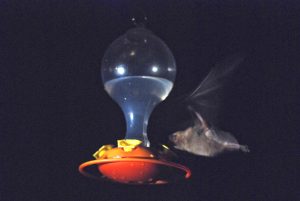If your hummingbird feeder is emptying quickly, it may be because bats are feeding from it. There are two types of nectar-feeding bats that use hummingbird feeders in Tucson. The two bats are the Mexican long-tongued bat and the endangered lesser long-nosed bat.
Bats have learned that hummingbird feeders are a source of food. Bats are probably using a hummingbird feeder if it is drained more quickly than usual. Also if bats are using the feeder there will be more drainage at night.
Bats can easily drain a hummingbird feeder. A single Mexican long-tongued bat can consume 0.67 of an ounce, in 106 minutes. The bat takes in 96 percent of their body weight. (They swell like a water balloon.) Then the bat will hang upside down and quickly digest the sugar water. Then the bat will urinate and return to the feeder for more sugar water.
Bats cannot hover so they use the feeder differently from the hummingbirds. The bat will stall, shoot their impressively long tongues up to six times a second into the feeder, and as they begin to fall will flap their wings.
Bats are not harmed by using the hummingbird feeders. Also, the hummingbirds will not be harmed by bats using hummingbird feeders.
These bats feed on agave, saguaro bloom, organ pipe and cardon cacti. Most nectar bats do not feed on red flowers, but the bats have adjusted to the red of hummingbird feeders.
The bats have also learned to dine on Mexican bird of paradise and prickly pear fruit. Even though the bats cannot get past prickly pear spines, they scavenge prickly pear fruit that had been plucked and opened by other animals.
Sources:
"Hummingbird feeders hijacked by piggy bats." Arizona Daily Star. October 8, 2006 Page B1.
"Flying 'migrants' have an appetite." Arizona Daily Star. May 24, 2010. Page A2.
Find the information you need by calling the Library's Infoline at 520-791-4010 or by sending your question to Ask a Librarian.

